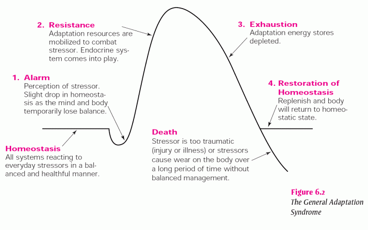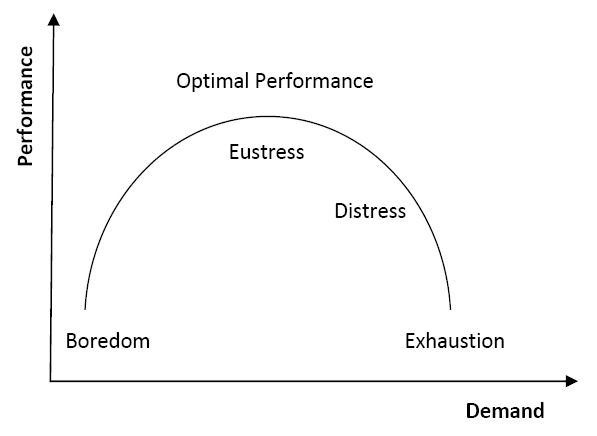Psychology Topics > Stress
Every living thing on the earth encounters stress in one degree or another. Stress is defined as emotional, mental or physical strain in response to a stressor (event, person, situation, thing). Stress manifests with particular symptoms such as anxiety, worry, irritability, and difficulty concentrating.
Stress can also result in physical symptoms such as increased adrenaline, muscular tension, stomach pain, and exhaustion. Stress over a long period of time has also been correlated with increased risk for heart disease and cancer.

Original picture credit to Noel C. Gill: http://www.onefunsite.com/donkey.shtml
Like the donkey in this picture, too much stress disables even resilient individuals. The difficulty is not in the individual per se, but the stress overloads the individual's ability to cope. In the case of the donkey, some things are just too heavy.
However, it's important to keep in mind that not all stress is bad. In fact, there's a type of stress that's actually good for us. It's true! We'll cover this a bit later.
There are three types of coping with stress: emotion-focused, problem-focused and avoidance. Emotion-focused is a coping style in which the individual tries to diminish his or her negative emotions resulting from stress. Problem-focused is a coping style in which the individual faces the problem head on, i.e. the person actively takes action to fix or resolve the problem. Avoidance coping is avoiding emotions and solutions to problems in hopes that they will both disappear on their own.
To illustrate these styles, consider the following scenario:
Tony works in the bakery in a local grocery store. Tony was baking a big batch of cookies for a fundraiser but he mistook salt for sugar and put 5 cups of salt in the recipe. Tony experiences stress because he doesn't have very much time left to complete the order. Now, let's look at this scenario using the three different styles...
- Emotion-focused: Tony sits down and takes several cleansing breaths to calm down. Tony also turns on some music to distract himself from his anxiety.
- Problem-focused: Tony quickly empties the mixer and starts over. Tony also places a phone call to the customer and apologizes because he is 15 minutes behind schedule.
- Avoidant: Tony keeps following the recipe, adds extra Stieva and hopes no one will notice.
The worst form of stress results from traumatic events. Acute stress disorder and posttraumatic stress disorder are both disorders resulting from trauma. Posttraumatic stress disorder has also been referred to as "shell shock" (a traumatic disorder from engaging in war combat.) Other traumatic events may include: car or other similar accidents, rape or assault, witnessing a violent crime, bank robbery or other hostage situations, kidnapping, any form of child abuse, domestic violence, natural disasters, unexpected death of a significant person, learning of a physical illness, and other highly traumatic events not mentioned.
The symptoms of traumatic stress disorders are nightmares, flashbacks (intense remembering of the event), attempts to avoid the memory, denial, high anxiety, depression, depersonalization or derealization (the feeling that one is in a dream or watching themselves from outside their body), etc.
Not everyone that experiences a traumatic event will develop a stress disorder. Certain factors increase the risk that a personal will develop a stress disorder. These factors are: low resistance, no social or family support, recurrent trauma over a long period of time, age, unhealthy coping skills, and no treatment. The faster treatment is available to people who have experienced trauma, the lower the risk is for developing stress disorders. In contrast, the longer people are in denial about their traumatic experience, the more likely they are to develop a stress disorder and the more difficult treatment becomes.
It should also be noted, however, that everyone who experiences trauma will have resulting reactions and emotions such as shock and or denial in the first 24 hours to a few days. This is a normal reaction to trauma and does not mean one is weak or flawed. Referring again back to the donkey in the picture, some things are just too heavy.
Hans Selye
Hans Selye was an endocrinologist, a type of specialist who treats disorders connected with glands and hormones in the body. Selye coined the word "stress" to refer to inappropriate physical reactions to any demand. He further divided this term into 2 types of stress, eustress and distress. Eustress is good stress, i.e. stress that motivates and improves function. Distress is overwhelming stress that results in anxiety, depression, and the other symptoms mentioned above.
Selye also developed the general adaptation syndrome. This consists of three stages. In the alarm stage, the individual has a "flight or fight" response and his or her ability to cope with the stressor increases. This ability continues to increase in the resistance stage until the individual starts to tire, wear down and become exhausted (exhaustion stage.)

Original picture: Teaching Today's Health Chapter 6: Mental Health and Stress Reduction
Richard Lazarus
Richard Lazarus argued that stress is unique to each individual and is dependant on appraisal (perception of stress). Lazarus believed that an individual appraises a situation and if it is stressful, the person starts using coping skills. He described two types of coping styles. The first one, problem solving, consists of managing the problem. The second, emotion-focused coping, is used to manage the negative emotions resulting from the stress.
Walter Cannon
Walter B. Cannon was an American Physiologist who coined the phrase "fight or flight" and the word homeostasis. "Fight or flight" refers to the response that animals and people have to a threatening situation. During "fight or flight" people are able to exert a great deal of energy in a short period of time due to increased blood flow, oxygen, and glucose stores. This response can cause damage to the body, however, it is a survival mechanism that can save the person's life. This explains why prolonged stress causes such a wide variety of physical symptoms.
Cox and MacKay
Cox and MacKay devised a model of stress that reflected the eustress of Hans Selye. Their model differed from the general adaptation model in that it illustrated the level of stress affects on performance. Cox and MacKay stated that too little stress resulted in boredom and low performance. Too high stress results in exhaustion and low performance. Optimum performance is a balance where stress is neither to high or too low.

Original pciture: http://wikieducator.org/Introduction_to_Stress_Theory
Bruce McEwin
Bruce McEwin described stress effects on the body by a term he called allostatic load. An allostatic load is a reflection of how stress hormones such as cortisol are affecting the immune system. When the body experiences stress, it secretes a hormone called cortisol. Cortisol raises the body's blood sugar in preparation for "fight or flight." Chronically high cortisol levels alter the immune system so that the body cannot fight disease effectively.
This chronically high level of cortisol and lowered immune function in response to stress is defined as a high allostatic load. High levels of cortisol can also damage cells in the brain that regulate the cortisol levels resulting in a lowered resistance to stress.
Meyer Friedman and Ray Rosenman
Friedman and Rosenman identified a high risk personality for stress induced illnesses called the Type A personality. A Type A personality is a set of behavioral features favoring achievement, competition, time urgency, impatience and hostility. Researchers have found that Type A characteristics are correlated with a higher risk of heart disease in these individuals.



